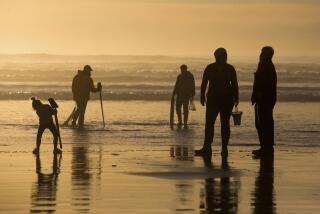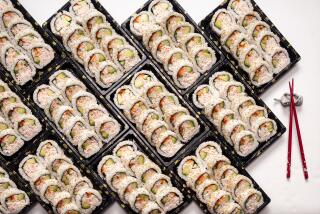Oregon Sea Urchin Gonads a Big Success With Japanese
- Share via
PORT ORFORD, Ore. — Hard and spiny on the outside. Smooth and creamy on the inside.
Here at Pacific Premium’s urchin harvesting plant, they like their seafood that way. Owned by a cooperative of 25 Oregon urchin harvesters, Pacific Premium Seafoods processes an average of 2 million pounds of the giant red sea urchin each year.
Almost all of the catch goes to Japan, where the reproductive organs, or gonads, are considered a delicacy.
“They kind of have the texture of an avocado,” said Travis Mecham, plant manager. “But I don’t think there’s anything you can really compare it to. I’ve tried them before, and I guess I’ll try them again sometime.”
Not exactly a ringing endorsement for the mushy, rather tasteless yellow slabs, but that’s OK. The Japanese love them, and pay $10-$50 for a half-pound box.
Satisfying the strict quality guidelines of the Tsakiji (pronounced skee-gee), or seafood market in Japan isn’t easy, however.
After extracting the gonads, workers must group them according to a list of tough criteria: color, quality, size, shape, body and fullness. The reproductive organs are the same in both male and female urchins, Mecham said.
Workers must also pack them neatly on small wooden trays, with straight lines and no holes. Presentation is everything.
“A lot of people say the Japanese eat their food with their eyes,” Mecham said. “They’re very quality-oriented. You have to tailor your product to their needs, and they’re pretty finicky.”
The processing plant crunches up the shells of the urchins for use as fertilizer, Mecham said.
Harvests have been shrinking over the last decade, said Neil Richmond, crab and sea urchin biologist with the Oregon Department of Fish and Wildlife. Divers caught 9.3 million pounds in 1990, but only 1.8 million pounds in 1994. Mecham said the reason for the drop is a concentration on quality.
“I’m sure that there are less out there than there used to be,” Mecham said. “But the price has gone up and poundage has gone down.”
There are huge pockets of urchin out there, but nobody will pick them because the quality isn’t very good.”
Mecham said the co-op members also imposed a 1,500-pound limit per boat last year to keep from over-harvesting.
Harvesting began on the Oregon Coast only nine years ago and the department hasn’t compiled enough data to fully assess the effect it has had, Richmond said.
“We don’t know whether or not the abundance we have now is anything like a historical average, because we don’t have sea otters anymore,” Richmond said.
“But we’re learning a lot. In the beginning, there was so little information. We were really managing by the seat of our pants.”
In California, where sea otters still live, there are not enough urchins to make a harvesting operation feasible, Richmond said. Half of the urchins harvested in Oregon are caught in Port Orford, and the rest in Brookings and Depoe Bay.
Mecham said the kelp beds off the coast of Port Orford still yield a good number of urchins.
More to Read
Sign up for The Wild
We’ll help you find the best places to hike, bike and run, as well as the perfect silent spots for meditation and yoga.
You may occasionally receive promotional content from the Los Angeles Times.






